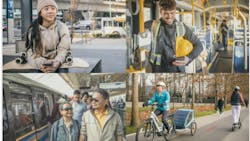TransLink’s Transport 2050 sets bright new vision for regional transportation
The Mayors’ Council on Regional Transportation and the TransLink Board of Directors have approved Transport 2050, making the regional strategy final.
Transport 2050 outlines a new long-range vision for Metro Vancouver and will guide transportation decisions for the next three decades.
“Quality transportation is the backbone of a quality society because how we move impacts every facet of urban life,” said TransLink CEO Kevin Quinn. “I’m proud that Transport 2050 will help make transportation more sustainable, reliable, convenient, safe and affordable for decades. After the largest engagement in our history, Transport 2050 is truly a strategy created both by those and for those who call Metro Vancouver home.”
The newly approved Regional Transportation Strategy outlines more than 100 actions or strategies to make transportation options more convenient, reliable, affordable, safe, comfortable and environmentally sustainable.
Some key actions in Transport 2050 include:
- Quadrupling the rapid transit network with more than 300 kilometers (186.4 miles) of new rapid transit.
- This could include bus rapid transit, light rail, subway or SkyTrain.
- Completing a connected 850-kilometer (528.2-mile) traffic-separated Major Bikeway Network to provide communities with greener and healthier transportation options.
- Promoting the use of electric and shared vehicles such as bikes, scooters and cars.
“In the time I’ve served as Mayors’ Council chair, previous long-range visions like Transport 2021 have influenced so many of the decisions that built what you see around you today,” said Jonathan Coté, chair, Mayors’ Council on Regional Transportation. “Transport 2050 is our new roadmap to a more livable Metro Vancouver. I’m proud that through engagement, members of the public have led this initiative from the beginning to set us on an ambitious path to a better region.”
Transport 2050 is a strategy for everyone in Metro Vancouver, regardless of whether they primarily drive, take transit, walk, cycle or roll. It was built through TransLink’s largest-ever public engagement – a three-phase process that began in 2019. In that time, TransLink hosted more than 350 in-person or virtual events that resulted in more than 160,000 conversations, 38,000 surveys and 4,000 ideas.
“Transport 2050 will guide our path to a better Metro Vancouver built on transportation options. I’m proud of the work that was done to make sure this strategy is representative of the communities that it will benefit,” said Lorraine Cunningham, board chair, TransLink. “On behalf of TransLink’s Board of Directors, we are excited to begin down this new path towards a brighter future.”
TransLink engaged directly with Indigenous Nations, urban Indigenous organizations and more than 500 stakeholder groups in 27 different municipalities. This included input from members of the public, representatives from all levels of government, organizations representing disadvantaged communities and numerous others throughout the Lower Mainland and surrounding areas.
TransLink will next work together with the Mayors’ Council to develop a detailed implementation blueprint that will prioritize shorter-term action items from Transport 2050. That blueprint is projected to be released later this year.
